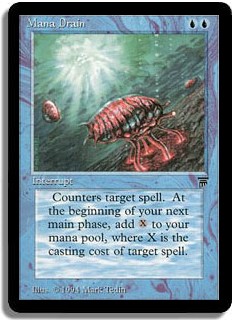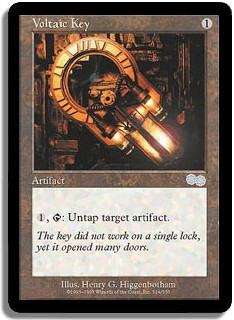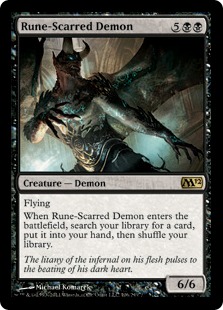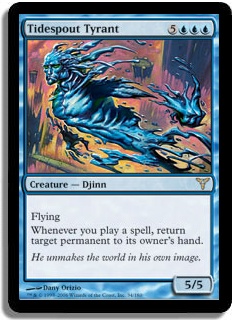The April installment of the LCV Vintage series is in the books, and the result is quite surprising. If somebody had told me after last month’s Dredge-a-thonthat hard line control would show up to Catalan and dominate the next tournament, I would have said, “I’ll believe it when I see it.”
“I’m a believer.”
There were 25 copies of Mana Drain, the jelly from helly, in the Top 16 decklists, and nine of the Top 16 decks chose to include the card.
In today’s article, I am going to focus solely upon the control decks from this event (sorry Workshops and Dredge, but you had your moment!) and discuss why this strategy appears to be on the rise.
“When Mana Drain decks are the best, you should play Mana Drains; when Mishra’s Workshop decks are the best, you should tune your Mana Drain deck to beat Workshops; when Fish decks are the best, you should tune your Mana Drain deck to beat creatures; when combo decks are the best, you should tune your Mana Drain deck to beat combo; and when Mana Drain decks are seemingly unplayable, you should still play Mana Drain because it is probably secretly the best.”
–The Control Player’s Prayer, Brian DeMars
To define control in Vintage is kind of a tricky subject. How truly controlling is a deck that can produce a turn 1 Blightsteel Colossus? Or on the first turn take infinite turns with the help of Time Vault and Voltaic Key?
“Key / Vault is technically a card advantage engine, right?”
Most Vintage control decks are technically more of a combo deck than true control. It is important to note that when I talk about control decks here that I am categorizing them by Vintage standards. The mark of the modern Vintage control deck tends to be that they play with the more reactive cards (permission and removal) and leverage these spells with card advantage (draw spells and planeswalkers).
By archetype, here is what the final standings of the Top 16 ended up looking like (Cantero and Minon split in the finals):
1st / 2nd – Gush, Pau Cantero
1st / 2nd – Tezzeret Control, Carles Minon
3rd / 4th – Keeper, Ferran Relat
3rd / 4th – Forgemaster MUD, Israel Munoz
5th / 8th – Turbo Tezzeret, Joaquin Fernandez
5th / 8th – Forgemaster MUD, Adria Romero
5th / 8th – BUG Tempo, Jerome Suarez
5th / 8th – Oath, Jose Romero
9th – U/W RIP, Eduard Hernandez
10th – Burning Long, Josep Maria Garcia
11th – Espresso Stax, Javier David
12th – Dredge, Gerard Piella
13th – Tezzeret Control, Miguel Angel Rodriguez
14th – U/W Landstill, Marc Bertoni
15th – Forgemaster MUD, Jordi Carbonell
16th – Grixis Control, Javier Dominguez
First, let’s check out the two decks that split the finals of this month’s 43 player Mana Drain Extravaganza.
Creatures (1)
Lands (12)
Spells (47)
- 1 Brainstorm
- 1 Fastbond
- 3 Mana Drain
- 1 Vampiric Tutor
- 1 Mystical Tutor
- 1 Yawgmoth's Will
- 4 Force of Will
- 1 Sol Ring
- 1 Regrowth
- 1 Demonic Tutor
- 3 Island
- 1 Time Walk
- 1 Ancestral Recall
- 1 Mana Crypt
- 4 Gush
- 1 Timetwister
- 1 Gifts Ungiven
- 2 Brain Freeze
- 1 Merchant Scroll
- 1 Misdirection
- 1 Rebuild
- 1 Black Lotus
- 1 Lotus Petal
- 1 Mox Emerald
- 1 Mox Jet
- 1 Mox Sapphire
- 2 Remand
- 3 Repeal
- 1 Ponder
- 1 Nihil Spellbomb
- 1 Noxious Revival
- 2 Flusterstorm

Planeswalkers (4)
Lands (11)
Spells (46)
- 1 Sensei's Divining Top
- 1 Brainstorm
- 4 Mana Drain
- 1 Vampiric Tutor
- 1 Mystical Tutor
- 1 Yawgmoth's Will
- 4 Force of Will
- 1 Mana Vault
- 1 Sol Ring
- 1 Demonic Tutor
- 5 Island
- 1 Time Walk
- 1 Ancestral Recall
- 1 Mana Crypt
- 1 Time Vault
- 1 Gifts Ungiven
- 1 Thirst for Knowledge
- 1 Echoing Truth
- 1 Misdirection
- 1 Tinker
- 1 Rebuild
- 1 Voltaic Key
- 1 Black Lotus
- 1 Mox Emerald
- 1 Mox Jet
- 1 Mox Pearl
- 1 Mox Ruby
- 1 Mox Sapphire
- 1 Nihil Spellbomb
- 1 Blightsteel Colossus
- 3 Mental Misstep
- 1 Noxious Revival
- 2 Flusterstorm

Both decks, despite being different archetypes of blue combo/control, share several commonalities. In the maindeck, both of them feature nearly the full package of Mana Drains (three in Gush, four in Tezzeret) to maintain control over the game until the pilot can flip the script and win with a game-ending combo. In the first case, Gush + Fastbond, and in the latter case, Tezzeret + Voltaic Key.
Also, five basic Islands!
Another thing I find really interesting about these decks is that both players opted for a transformational Oath of Druids sideboard, which probably functions as a solid plan against both Workshops and Dredge. I do find it fascinating that the Gush deck wants to Oath up Tidespout Tyrant and the Tezzeret deck Rune-Scarred Demon.
“You guys realize that Griselbrand is banned in Commander, not Vintage, right?”
My immediate thought is that you would want at least one Griselbrand as an option. Yet, on second thought, it is interesting that the targets don’t allow Workshop’s Phyrexian Metamorphs much of a blowout factor. While it looks odd to see, I also remember writing an article where I suggested Oathing up Pristine Angel because I didn’t want to lose to Workshop’s Metamorphs, and these card selections seem to be in a similar vein.
The transformational sideboard plan also provides both of these blue decks with the ability to board in more land against mana denial style Mishra’s Workshop decks, which is a nontrivial bonus!
Another thing I noticed about these two lists is that not including the Oath package both decks only play one graveyard specific hate card for the Dredge matchup. I haven’t tested these decks post-board with Oath of Druids to see how impactful it is against Dredge, but one card doesn’t seem like enough.
However, it could just be that these players had a really good read on the metagame and rolled the dice that they wouldn’t play against it. After all, it did win last month, and I did make a point of harping on the PLAY DREDGE HATE in my last LCV article. Maybe they figured that everybody would play a bunch of hate and others would be scared off Dredge. If this is the case, it could be reasonable to assume very little Dredge for this particular event.
But for future reference, if I were going to play in a Vintage tournament, I would find room for a more substantial Dredge/graveyard hate package.
The similarities between these two lists are so strong that I would predict that one of the following two statements is true:
1. These two players test together.
2. These two players don’t test together, but both had a perfect read for what the metagame would look like this month.
Yeah, yeah. I realize I just made the statement that one of these two options is true: these two players test together or don’t test together. My guess is that they test together.
Whatever is the case, congratulations to Cantero and Minon. You two did a great service to all of us Mana Drain fans around the globe!
Let’s take a look at some of the other controlling decks that did well in this event.
Creatures (8)
Planeswalkers (2)
Lands (17)
Spells (34)
- 1 Sensei's Divining Top
- 1 Brainstorm
- 2 Mana Drain
- 1 Lightning Bolt
- 1 Vampiric Tutor
- 1 Mystical Tutor
- 1 Yawgmoth's Will
- 2 Duress
- 4 Force of Will
- 1 Swords to Plowshares
- 1 Sol Ring
- 1 Demonic Tutor
- 1 Island
- 1 Time Walk
- 1 Ancestral Recall
- 1 Tinker
- 1 Black Lotus
- 1 Vindicate
- 1 Mox Emerald
- 1 Mox Jet
- 1 Mox Pearl
- 1 Mox Ruby
- 1 Mox Sapphire
- 1 Blightsteel Colossus
- 2 Mental Misstep
- 2 Flusterstorm
- 1 Abrupt Decay

Ferran Relat’s “Keeper” deck looks like an interesting hybridization of Vintage Control and Grixis Control. He basically has the Vintage Control mana base with City of Brass but is also taking advantage of the Dark Confidant draw engine.
I like the idea of playing Dark Confidant in a City of Brass deck, and I really like the idea of bringing Deathrite Shaman into the mix. The one concern I have with this 75 is that it appears to be pretty soft to Dredge. Again, this could be people hedging that Dredge wasn’t going to show up to this event, but if I were taking a similar deck to a random event in the blind, I would play more graveyard hate.
One of the great things about Vintage is that the format always returns to the same meat and potatoes strategies that it has always been about. The banned and restricted list changes over time, new cards get printed and become hot for a while, and sometimes new decks pop up and become very good for a period, but the best cards (the Power Nine, Mana Drain, Mishra’s Workshop) will always be the driving force that shapes the Vintage path over time.
Once again, special thanks to Roger Riera.
Thanks for reading!
Cheers,
Brian DeMars





